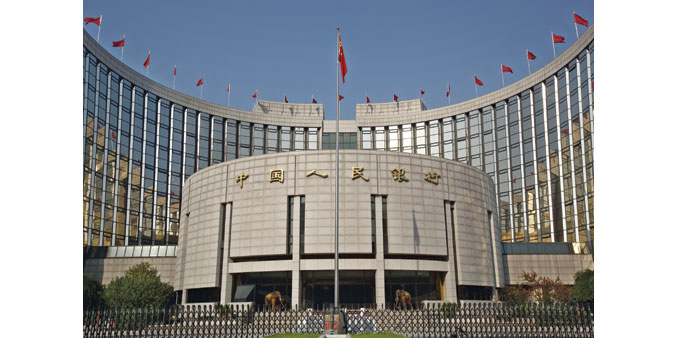The People’s Bank of China headquarters in Beijing. The PBoC last week signalled its intention to ensure adequate supply of cash in the financial system by lowering the rate on its Standing Lending Facility and injecting 10bn yuan through open-market operations, after keeping a net neutral position for two weeks.
Bloomberg
Taipei
While the dislocation between the bond and interest-rate swap markets is causing angst in the developed world, in China it’s seen as a good omen.
As in the US and the UK, sovereign yields higher than swap rates are a sign of insufficient liquidity in the government debt market. In China, the swap market is also quicker to reflect expectations for monetary easing. The Asian nation’s one-year contracts fell to 22 basis points below the sovereign yield last week, the most since May, while other tenors’ spreads have been in negative territory since August.
“Investors are probably more active using swaps to express the view that there may be more benchmark rate cuts,” said Frances Cheung, head of Asia ex-Japan rates strategy at Societe Generale in Hong Kong. “China’s bond market isn’t as liquid as those in advanced economies, so when interest rates fall and you’re bullish, you may not be able to keep buying bonds in a timely manner.”
Six central bank benchmark rate reductions in the past year have failed to revive inflation and reverse a contraction in manufacturing and exports, spurring speculation that further easing is on the way. While China’s bond market is the world’s third-largest, annual trading as a ratio of total outstanding debt is 1.1, compared with 4.7 in the US, according to Bloomberg calculations. The People’s Bank of China last week signalled its intention to ensure adequate supply of cash in the financial system by lowering the rate on its Standing Lending Facility and injecting 10bn yuan through open-market operations, after keeping a net neutral position for two weeks. A private manufacturing gauge due December 1 will probably show a ninth month of declines in November, while a separate Bloomberg survey of economists signals factory prices will drop for a 45th month.
“The market now thinks the probability of the economy stabilizing in the short term isn’t high,” said David Qu, a rates strategist at Australia & New Zealand Banking Group in Shanghai. “So it’ll be a long slowdown cycle, and with that, there’ll be a long easing cycle.”
He attributed a recent rise in yields to a rebound in the stock market, a resumption of new share sales luring cash away from debt and concern of increased issuance of municipal bonds. China is said to be planning to raise a quota to swap high-cost local government borrowings with cheaper notes by as much as 25% to 4tn yuan.
The 10-year government bond yield rose to a one-month high of 3.21% on November 9, before dropping to 3.05% on Thursday. The notes were poised for their first weekly advance in a month as Friday data showed a decline in industrial profits accelerated to 4.6% in October from 0.1% in the prior month.
Swap spreads have dropped in developed markets this quarter as tightening capital rules made it costlier for banks to be market makers for sovereign debt. In China, the market is dominated by banks that favour buy-and-hold strategies because overseas investment is capped by quotas and household savings are mostly stored in simple deposits. Around 67% of government notes were owned by commercial banks in October, according to ChinaBond data.
“There’s room for the authorities to improve the bond market, like by reducing the intermediary cost for investors to participate in the market, allowing more participants including overseas investors, and building a more efficient system for trading,” said Yang Chen, a rates strategist at Bank of America Merrill Lynch in Hong Kong. “They will move in this direction and at the same time continue to ease monetary policy, but we don’t expect aggressive moves.”
In the last easing cycle sparked by the global financial crisis, one-year swap spreads fell below zero two months before the PBoC cut interest rates, and stayed in the minus as four more reductions came. The contracts also started trading below bond yields three months before the current cycle began a year ago. The seven-day repurchase rate, the floating rate for the swaps, has averaged 2.35% this quarter, the lowest since the third quarter of 2010.



